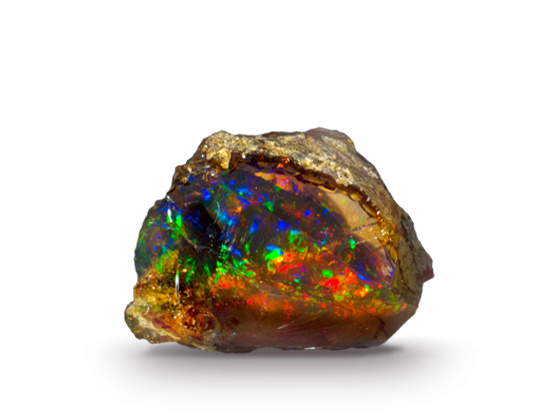OVERVIEW
Because opal has the colors of other gems, the Romans thought it was the most precious and powerful of all. The Bedouins believed that opals contained lightning and fell from the sky during thunderstorms. When Australia’s mines began to produce opals commercially in the 1890s, it quickly became the world’s primary source for this October birthstone.
Opal is the product of seasonal rains that drenched dry ground in regions such as Australia’s semi-desert “outback.” The showers soaked deep into ancient underground rock, carrying dissolved silica (a compound of silicon and oxygen) downward.
During dry periods, much of the water evaporated, leaving solid deposits of silica in the cracks and between the layers of underground sedimentary rock. The silica deposits formed opal.
How Opal Forms
Opal is known for its unique display of flashing rainbow colors called play-of-color. There are two broad classes of opal: precious and common. Precious opal displays play-of-color, common opal does not.
Play-of-color occurs in precious opal because it’s made up of sub-microscopic spheres stacked in a grid-like pattern—like layers of Ping-Pong balls in a box. As the lightwaves travel between the spheres, the waves diffract, or bend. As they bend, they break up into the colors of the rainbow, called spectral colors. Play-of-color is the result.
- Mineral: Hydrated Silica
- Chemistry: SiO2•nH2O
- Color: All colors
- Refractive index: 1.37-1.47
- Birefringence: None
- Specific gravity: 2.15 (+0.08, -0.90)
- Mohs Hardness: 5 to 6.5
WHERE IS IT FOUND ?
The opal birthstone can be found in many places. The fields of Australia are the most productive in the world for the October birthstone. Ethiopia, Mexico and Brazil are also important sources. Additional deposits have been found in Central Europe, Honduras, Indonesia, Madagascar, Peru, Turkey and the United States.
Lightning Ridge, a small town in New South Wales, Australia, is famed for producing prized black opal. A dry and rocky region softened only by small trees and scrub brush, Lightning Ridge gets little rain and bakes in the scorching summer temperatures. The climate is so unforgiving that miners often live underground to find respite from the punishing heat.
CARE & CLEANING
Opal may be treated by impregnation with oil, wax or plastic. Opal doublets or triplets are fine slices of opal glued to a base material and covered with a thin dome of clear quartz. The safest way to clean this October birthstone is with warm, soapy water. Other cleaning methods might damage the opal or filler material. Note that prolonged exposure to water may weaken the adhesive in opal doublets and triplets. Even natural opal can fracture if exposed to high heat or sudden temperature changes.
This October birthstone ranges from 5 to 6.5 on the Mohs scale of hardness. To prevent jewelry set with harder gems from scratching opal, store it by itself. Diamonds, rubies, sapphires, and emeralds are just a few of the gems that can scratch the October birthstone.
BIRTHSTONE
Opal is an October birthstone.
HISTORY
Writers have compared opals to volcanoes, galaxies, and fireworks. Admirers gave extraordinary opals poetic names like Pandora, Light of the World, and Empress. In ancient Rome, this gem symbolized love and hope. The Romans gave it a name—opalus—that was synonymous with “precious stone.”
In 75 AD, the Roman scholar Pliny observed, “Some opali carry such a play within them that they equal the deepest and richest colors of painters. Others…simulate the flaming fire of burning sulphur and even the bright blaze of burning oil.” He marveled that this kaleidoscopic gem encompassed the red of ruby, the green of emerald, the yellow of topaz, the blue of sapphire, and the purple of amethyst.
Many cultures have credited opal with supernatural origins and powers. Arabic legends say it falls from the heavens in flashes of lightning. The ancient Greeks believed opals gave their owners the gift of prophecy and guarded them from disease. Europeans have long considered the gem a symbol of hope, purity, and truth.
Opal is considered an October birthstone. Some people think it’s unlucky for anyone born in another month to wear an opal. But that particular superstition comes from a novel written in the 1800s (Anne of Geierstein by Sir Walter Scott), and not from any ancient belief or experience. In fact, throughout most of history, opal has been regarded as the luckiest and most magical of all gems because it can show all colors. Once, it was thought to have the power to preserve the life and color of blond hair.
Source of Content : www.gia.edu


